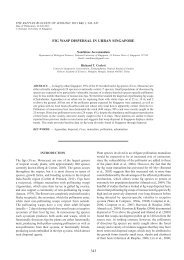1O257LF
1O257LF
1O257LF
Create successful ePaper yourself
Turn your PDF publications into a flip-book with our unique Google optimized e-Paper software.
© 2010 Dinosauria International Ten Sleep Report Series No. 1<br />
A<br />
B<br />
C<br />
Fig 16 A. posterior caudals with associated chevrons terminating in an unusual pathology displaying bone overgrowth in DQ-SB.<br />
B. close up of the left side. C. close up view of right side of terminal caudal.<br />
the actual specimen could not be examined while in plaster<br />
jackets. All five specimens are, at present, in various states<br />
of preparation and cannot be described individually in<br />
more detail at this time. Many of the photographs presented<br />
here reflect these various states. What follows is, therefore,<br />
a preliminary description from a work-in-progress. Future<br />
reports are planned which will include complete descriptions<br />
with comparisons of and new specimens. Also planned is a<br />
phylogenetic study incorporating cladistic methodology.<br />
DQ-BS = “Brontodiplodocus”, Table 1, Figs: 1, 5 - 8, 19, and<br />
21<br />
This specimen marks the first skeleton to be found<br />
with a skull preserved intact and articulated to a nearly<br />
complete series of cervical vertebrae. The skull, lower jaws,<br />
and the five cervical vertebrae complete with ribs are kept in<br />
situ in the original matrix block. The skeleton is estimated<br />
to be 80-90% complete, and the free-standing mount is 24.68<br />
m. (81 feet) in length, in contrast the reconstructed skull<br />
is approximately 36 cm (14.17 inches) long. Preliminary<br />
observations suggest the individual was a young adult when<br />
it died. However, the exact age of this individual is under<br />
investigation at the Division of Paleontology, American<br />
Museum of Natural History. This study will rely on taking a<br />
thin section of sclerotic bone for dating, a first for sauropod<br />
paleobiology.<br />
The intact skull displays all the delicate cranial bones<br />
largely without distortion (Figs. 4 & 5). Although displaced,<br />
even the fragile sclerotic bones are preserved complete in<br />
their orbital cavity. The pear shaped orbital opening is<br />
relatively large and extends anterior-ventrally with a slight<br />
constriction located at the anterior margin created by a bulge<br />
on the lacrimal. The extended shape of the orbit is in some<br />
ways reminiscent of the condition present in large derived<br />
theropods (Chure 1998). The lower jaws are preserved<br />
articulated. Only the premaxillae were displaced during<br />
excavation and cannot be seen in the accompanying photo.<br />
In addition to the orbit and nasal openings, the preantorbital,<br />
antorbital, supratemporal, and lateral temporal fenestrae<br />
are all complete and without distortion. The interfenestra<br />
bridge (Witmer 1997) dividing the preantorbital from the<br />
antorbital fenestrae is well preserved. Resting above the<br />
occipital condyle are the small and rarely found proatlas<br />
bones, which are preserved in situ along with the atlas.<br />
The occipital condyle is ventrally positioned nearly at a<br />
right angle to the long axis of the skull, as in all Morrison<br />
diplodocids. Numerous teeth are scattered in the matrix<br />
block preserving the skull. The crown of an unworn tooth<br />
is slightly compressed labial-lingual and tapers towards the<br />
apex with an outline that is narrow spatulate. A slight lingual<br />
curve exists on the crown and on that surface a faint ridge<br />
running down its length is discernable. The root is nearly<br />
cylindrical in cross section.<br />
Every bony process, spine, and rib along the<br />
cervical series is preserved on the thirteen vertebrae that<br />
18



